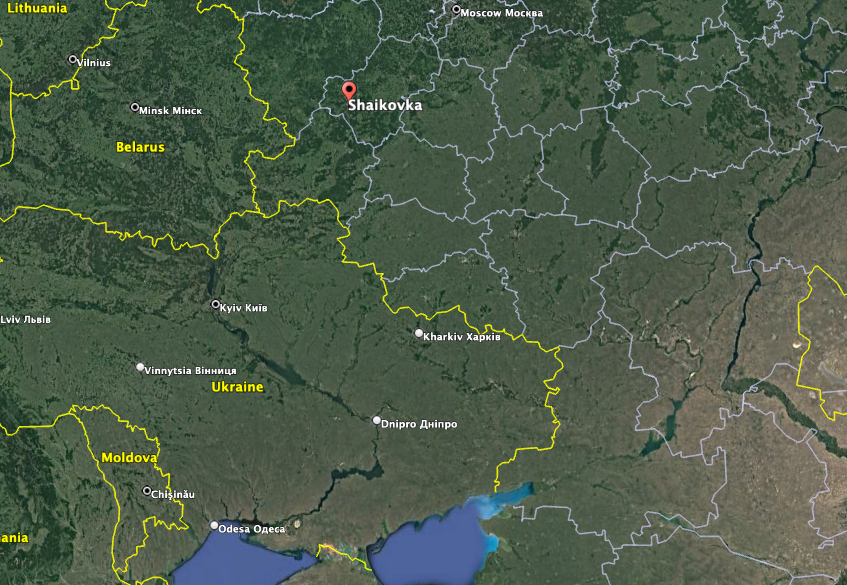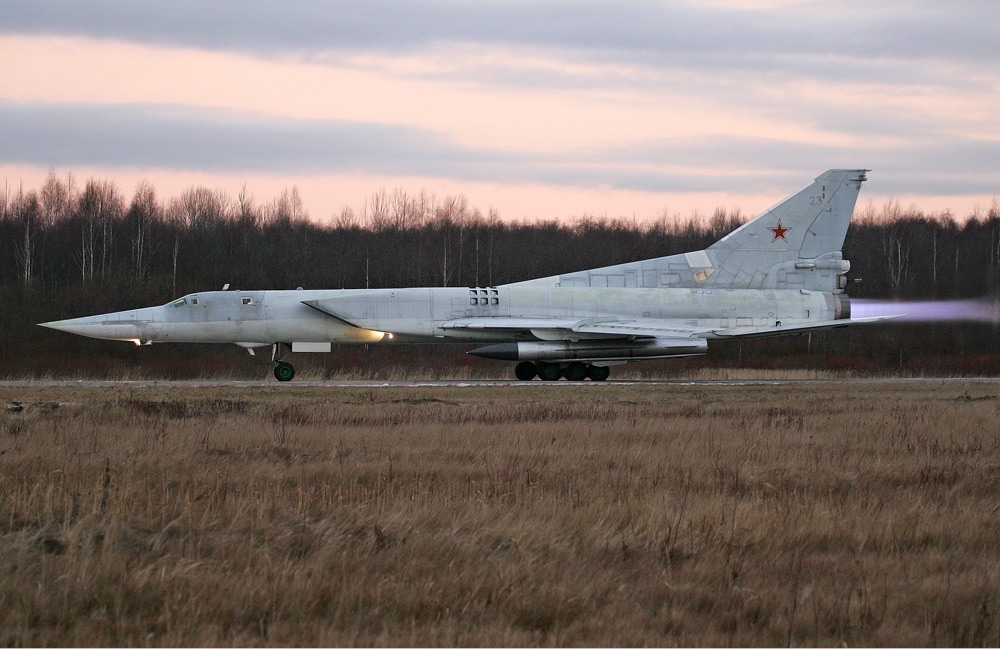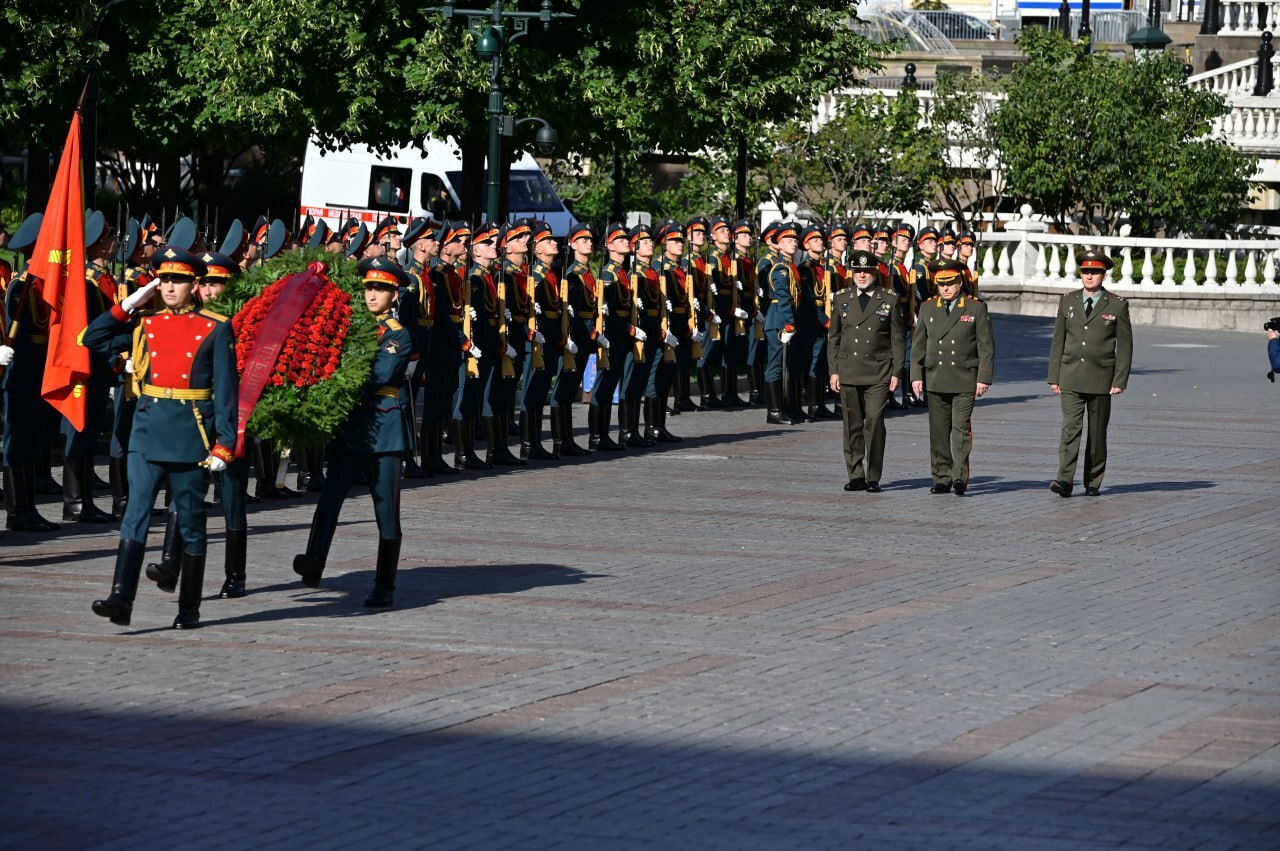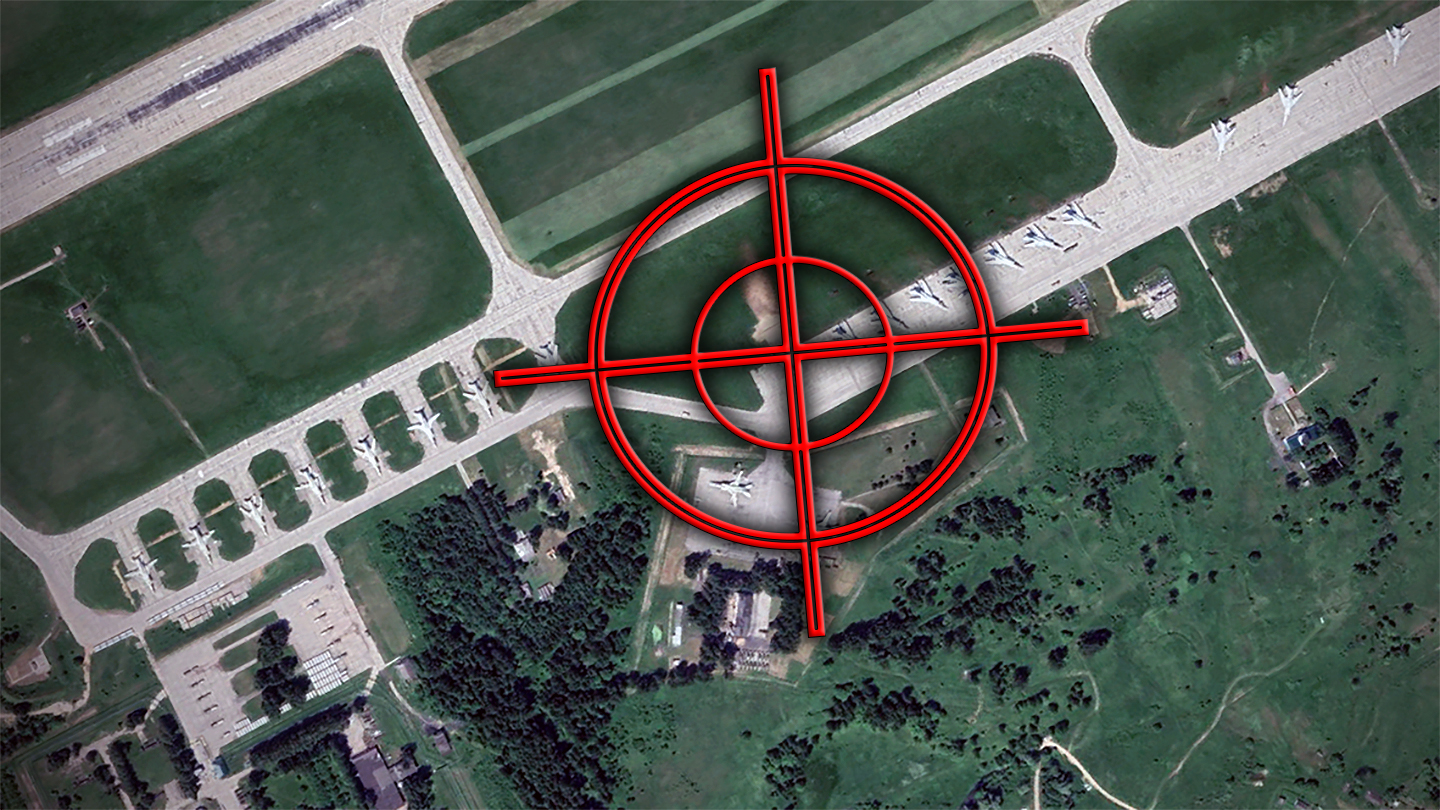Ukraine’s Defense Intelligence Directorate (GUR) is taking credit for two drone attacks on Russian airbases over the past three days, telling The War Zone that it recruited people to attack the Soltsy-2 and Shaykovka airbases from inside the country.
“People recruited by the GUR came from central Russia, did their work and went back to their place,” GUR spokesman Andrii Yusov told The War Zone Monday. “GUR continues operations in Russia. In the border regions, in the deep rear and in Moscow.”
Yusov offered no proof and no imagery has yet emerged from what Russian sources are also saying was a Ukrainian drone attack on Shaykovka Monday. The base is located about 130 miles north of the Ukrainian border. However, Yusov said at least one aircraft was damaged at that base, home to Russian Tu-22M Backfire bombers from the 52nd Heavy Bomber Aviation Regiment. He did not specify what kind of aircraft was damaged Monday, but he told us that one Tu-22M Backfire bomber was destroyed Saturday in an attack on the Soltsy-2 airbase and two others were damaged. Unlike Monday’s attack, vivid photos emerged on social media of a Backfire bomber at Soltsy-2 engulfed in flames. You can read more about that attack in our original story here.
Russian media on Monday confirmed a drone attack on Shaykovka, but there were conflicting reports about the resulting damage.
Kaluga Oblast Gov. Vladyslav Shapsha said there was no damage after an attempted drone attack in the district where Shaykovka is located.
“This morning, despite difficult meteorological conditions, a UAV attack was repelled on the territory of the Kirovsky district,” Shapsha said on his Telegram channel Monday. “There were no injuries or damage to infrastructure.”

MASH said the airfield itself was attacked.
“A Ukrainian UAV fell on the territory of the airfield today at about eight o’clock in the morning,” MASH reported on its Telegram channel Monday.
The drone was spotted early and shot down, MASH reported.
“A crater formed at the site of the drone crash and a fire broke out, which was extinguished by people on the spot, without the involvement of the Ministry of Emergency Situations. Previously, there were no casualties or destruction.”
Baza had a different take.
“A kamikaze drone fell on the territory of the airfield on the morning of Aug. 21,” Baza reported on its Telegram channel Monday. “According to preliminary information, an unused aircraft located at the airfield was damaged as a result of the fall. However, this information has not been officially confirmed.”
Baza did not specify what kind of aircraft was damaged.
This marks the second Ukrainian drone attack on Shaykovka in just under a year. The airbase was also attacked last October and a Ukrainian source at the time told us that two Russian Backfire bombers were destroyed. Russian officials pushed back against that claim and satellite imagery did not support it, but we could not see the entire base. You can read more about that here.
As we noted yesterday, the Soviet-era Tu-22Ms, which launch supersonic Kh-22 and newer Kh-32 cruise missiles, have been a major problem for Ukraine since not long after Russia’s all-out invasion of the country.

Tu-22M3 with a Kh-22/32 under its wing. (Dmitriy Pichugin via Wikicommons)
The drone used in Monday’s attack was “a civilian copter, retrofitted with IEDs and a reinforced battery,” MASH reported. The Russian Defense Ministry, as we reported on Sunday, said Soltsy-2 was attacked by “a copter-type UAV.”
Those descriptions fit with our suggestion on Sunday that these attacks could be launched from inside Russia as opposed to from Ukraine and lends additional credence to the GUR claims. Ukraine has long proven it has the ability to conduct long-range drone strikes on Russian airfields. There have also been sabotage attacks on Russian airfields far from Ukraine as well as other locally-conducted small drone attacks on Russian aviation assets in the past.
This latest series of drone attacks on Russian military installations seem to live up to a promise made last month by Ukrainian President Volodymyr Zelensky that such strikes will only continue.
Before we head into the latest news from Ukraine, The War Zone readers can catch up on our previous rolling coverage of the war here.
The Latest
On the battlefield, Ukraine claims it has made further advances near the town of Robotyne in Zaporizhzhia Oblast.
“Our units were successful in the direction of southeastern Robotyne and south of Mala Tokmachka of Zaporizhzhia Oblast,” Ukrainian Deputy Defense Minister Hanna Maliar said Monday on her Telegram channel. “The enemy tried to regain lost positions east of Robotyne. But unsuccessfully. Planned combat work is currently underway in Robotyne.”
The Russians, meanwhile, continue to press their attack toward Kupiansk in Kharkiv Oblast, she said.
“In the Kupiansk direction, the enemy is storming and shelling. Our troops repel attacks, hold the border and prevent the enemy from advancing,” she said. “In particular, the defense forces repelled enemy attacks in the Pershotravneve, Synkivka, Petropavlivka districts of the Kharkiv region.”
The Russian Defense Ministry (MoD) on Monday said its forces are achieving success around Kupiansk.
“Units of the Zapad Group of Forces, supported by Operational-Tactical Aviation and artillery, improved the situation along the front line,” the Russian MoD said Monday on its Telegram Channel. There were “four attacks by units of 25th airborne, 95th airborne assault and 14th mechanized brigades of the [Armed Forces of Ukraine] that have been repelled close to Sinkovka (Kharkiv Oblast) and Novosyolovskoye (Luhansk Oblast).”
The increased Russian shelling of Kupiansk led to local officials ordering a civilian evacuation earlier this month.
Speaking of the battle for Kupiansk, Ukraine’s frontline troops say that the U.S.-provided cluster munitions they’ve received are having a devastating effect on Russian forces trying to advance on that city.
“When we start firing the cluster munitions, the Russians disappear under hard cover. They won’t even poke their noses out,” Stanislav, a Ukrainian military official standing a few miles from the front line in a blackened forest still smoldering from Russian shelling, told The Washington Post.
The Pentagon last month announced it was sending Ukraine “hundreds of thousands” of rounds of cluster munitions known as Dual-Purpose Improved Conventional Munitions (DPICMs).
“The main benefit is that the enemy is now very scared to go on [the] assault,” said Stanislav, who spoke on the condition that only his first name or call sign be used because of security concerns in discussing sensitive military matters.
Russian units advancing with armored vehicles and unmounted infantry halt their forward movement to allow troops to seek cover from the ricocheting shrapnel, soldiers told the Post. “They even recognize the cluster bombs by the whistle they make when headed their way,” said Stanislav, a member of Ukraine’s 14th Mechanized Brigade.
“Stanislav’s crew fires cluster munitions from a hulking M109 Paladin nestled under the cover of severed pine branches and tall trees,” the Post reported. “The U.S.-made self-propelled howitzer can fire a cluster munition a distance of more than 15 miles and can adjust the width of bomblet spray across several football fields or a narrower range depending on the operator’s preference, Stanislav said. The crew is also armed with cluster munitions that scatter mines on the ground.”
You can read more about DPICMs, how they work and why they are controversial, in our story here.
A day after the Netherlands and Denmark pledged to provide Ukraine with dozens of F-16 Vipers, the Ukrainian Air Force spokesman said that many more are needed.
In an interview with Radio Svaboda Monday, Ukrainian Air Force Col. Yuri Ignat said that “128 fighters are needed by Ukraine in order to replace the old aviation fleet of equipment, such a number is prescribed in the vision of the Air Force of the Armed Forces of Ukraine.”
Ignat, however, said that figure was adjustable.
“… more than 100 aircraft really need to be deployed at different airfields so that they respond to various challenges and strike at different targets. And on planes, and on ground and on the rear of the enemy, in particular,” he said.
Ignat also told Ukrainian TV that dozens of Ukrainian pilots, engineers and others will be trained to use F-16 fighter jets in Denmark. He added that another group of Ukrainian pilots will receive long-term military flight training in the United Kingdom that could last “up to two years.”
Meanwhile, Greece on Monday joined the coalition of nations agreeing to train Ukrainian pilots on F-16s.
“Greece will participate in training of our pilots for F-16. I am grateful for this proposal,” Ukrainian President Volodymyr Zelensky said during a joint press conference with Greek Prime Minister Kyriakos Mitsotakis in Athens, Reuters reported.
As a backup, that training could also take place in the U.S. if European nations don’t have the capacity, Deputy Pentagon Spokesperson Sabrina Singh told reporters Monday morning at the Pentagon.
He’s baaack.
In only his second video since his aborted mutiny at the end of June, Wagner boss Yevgeny Prigozhin claimed he was in Africa, helping fight jihadi groups there. He also put out the word that he is recruiting for additional fighters there, as the group looks to expand Russian influence on the continent. In addition to fighting in Ukraine, Wagner has played a big role in Africa, where it has come to the aid of new juntas in places like Mali. The continent was recently roiled by a coup in Niger, where there are concerns that Wagner could increase its influence as well. You can read more about that in our story here.
While Russia has big plans to build thousands of Iranian-designed drones domestically over the coming years, it may already be constructing them using components from its other weapons systems, Popular Mechanics is reporting.
The publication noted that on August 11, Conflict Armament Research (CAR), an organization investigating weaponry in conflict zones, published a report on two crashed kamikaze drones recovered in July. According to their report, while previously recovered ‘Geran-2s’ were confirmed to be of Iranian origin, those that crashed in July were different.
Geran, Russian for geranium, is how Moscow refers to the Shahed-136 drones.
CAR reported that the Russian-built version of those drones relies primarily on components sourced from China, Switzerland, and the United States. However, four components are uniquely made in Russia that weren’t on the original Iranian-built drones.
“The skin of the new Geran-2 itself is different: while the Iranian drones incorporate a honey-comb pattern material between skin surfaces, the new Russian ones use fiber-glass over carbon fiber,” Popular Mechanics reported, citing the CAR investigation. “The changes are more than skin-deep, though. The Geran-2’s satellite navigation, flight control and starter systems belong to the same, novel production set, with parts coded respectively B-105, B-101, and B-103. These streamline the original model’s more complicated Iranian architecture.”
Investigators, for instance, found that the B-105 satellite navigation unit was using a Kometa GNSS -system already identified in Russian-built Orlan-10 and Forpost surveillance drones and satellite-guided bombs, replacing the original’s multi-component system.
“The internal units documented by CAR in the Geran-2 UAVs indicate that the Russian Federation has distilled the principles of the Shahed series UAV, while simplifying its functioning by combining new solutions with existing ones like the Kometa, which have been battle-tested in other weapon systems,” CAR reported. “As a result, the Russian Federation will likely be able to produce more Geran-2 UAVs quickly to sustain its campaign in Ukraine.”
An Iranian military delegation arrived in Moscow Monday “to discuss issues of bilateral military cooperation in the field of land forces,” the Russian MoD reported on its Telegram channel.
“The official part of the bilateral talks took place at the Command of Land Forces, where the sides discussed issues of military cooperation and interaction aimed at implementing projects, the goals of which were [the] improvement of the combat readiness of the armed forces of both countries,” the Russian MoD said.
“Iran is considered by the Russian Federation as one of the key states in the Middle East – it is Russia’s strategic partner, and constant intensive political dialogue is a characteristic feature of the current stage of our partnership,” said Commander-in-Chief of the Russian Armed Forces’ Land Forces General of the Army Oleg Salyukov.

In a piece on the mood of Ukrainians after 18 months of war and a counteroffensive that is going slower than anticipated, The Economist found trouble may be on the horizon for President Volodymyr Zelensky.
“The public mood is somber,” the publication wrote on Sunday. “Criticism of Volodymyr Zelensky, the president, has increased, and the reasons for the dissatisfaction are clear. Having once promised a march to Crimea, occupied and annexed by Russia since 2014, the political leadership in Kyiv now emphasizes more realistic expectations.”
“We have no right to criticize the military sitting here in Kyiv,” Serhiy Leshchenko, a spokesman in the presidential office, told The Economist. He likened frustration with the speed of the counter-offensive to impatient customers waiting for their iced lattes in the capital’s many hipster cafes. “This isn’t a horse you can whip to go faster. Every meter forward has its price in blood.”
Ukraine’s leadership is particularly frustrated that Western equipment has not yet arrived in its promised numbers. It is “upsetting…and demotivating,” Leshchenko said.
“Equivocation among allies about the supply of newer weapons, and the prospect of America re-electing Donald Trump next year, have added to Ukrainian anxieties. A source in the general staff says that Ukraine has received just 60 Leopard tanks, despite the promise of hundreds. Demining vehicles are particularly scarce.”
“We simply don’t have the resources to do the frontal attacks that the West is imploring us to do,” says the source.
The 15th Kara-Dag Brigade of the Ukrainian National Guard released new video showing its troops assaulting a Russian trench position in Zaporizhzhia Oblast. The video shows the Ukrainians approaching in an armor column, then dismounting and attacking with rifles and hand grenades.

A building reportedly occupied by Russian forces in occupied Donetsk City was destroyed by a purported Joint Direct Attack Munition (JDAM). The Mark 80 series bombs have an add-on kit that uses inertial and GPS guidance to hit their static targets, becoming true fire-and-forget weapons. In this video below, the JDAM apparently strikes the top right section of the building’s roof, collapsing that section. The rest of the building crumbles as the blast waves spread.
Daytime maneuvers across crater-pocked fields are not just a challenge for Ukraine. A Russian mechanized assault south of Bakhmut was stopped by Ukrainian artillery, which destroyed a number of vehicles in the column.
Seven people were killed and nearly 150 injured Saturday by a Russian missile attack on Chernihiv, Ukrainian President Volodymyr Zelensky said Saturday on his Telegram channel.
Ukraine last Friday released this absolutely wild video showing one of its First Person Video (FPV) drones approaching, then flying into a building in occupied Energodar in Zaporizhzhia Oblast. The building was reportedly hosting a meeting of occupation police, many of who were said to have been injured in the attack.
A Ukrainian FPV drone was also used to reportedly destroy a Russian Pole-21 electronic warfare system designed to jam signals from satellites.
And finally, given that there is a full-on war taking place, the celebration of Ukraine’s 32nd Independence Day on Aug. 24 will obviously be muted. But Kyiv will hold a parade of destroyed Russian equipment in the capital’s central Khreshchatyk Street.
That’s it for now. We’ll update this story when there’s more news to report about Ukraine.
Contact the author: howard@thewarzone.com
